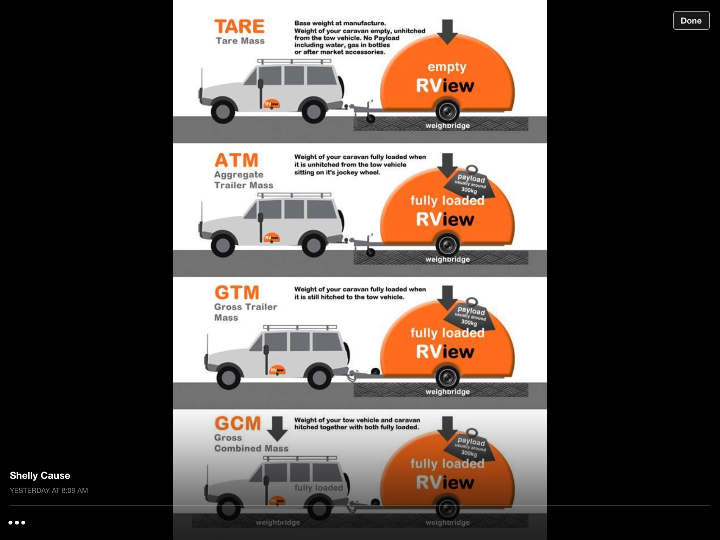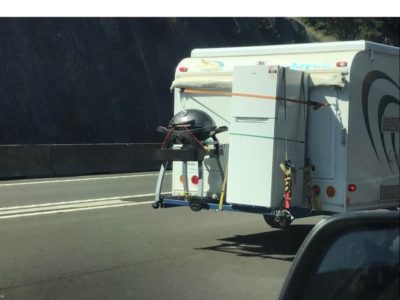A weighty problem
When it comes the time to consider a new caravan, perhaps for the first time, you’re faced with having to consider weight. When the dealer starts talking about Tare weight, ATM, GVM, GTM and ball weight – it can be quite confusing knowing what’s what when it comes to weight. Let me help.

Tare weight
There is a plethora of misconceptions about this one. You will find the Tare weight on the VIN plate.
While most think that Tare weight is the weight of the van when it’s empty. The trouble is, knowing what empty really means. Let’s skip past the plethora of misconceptions and go to the Australian Standards.
The appropriate Australian Standard says Tare weight, “is the total mass of the trailer when not carrying any load, but when ready for service, unoccupied (if relevant) and with all fluid reservoirs (if fitted) filled to nominal capacity except for fuel, which shall be 10 litres only, and with all standard equipment and any options fitted. This includes any mass imposed onto the drawing vehicle when the combination vehicle is resting on a horizontal supporting plane. (Fluid reservoirs do not include water tanks and waste water tanks fitted to caravans).
Simply put, while hydraulic fluid associated with hydraulic brake systems is part of the Tare weight. However, the mass of fresh, grey and black water tanks would not be included in Tare mass. That also means the gas in gas cylinders are not part of the Tare weight. All of these things are part of your payload. Simply put, if you have two 95 litre fresh water tanks and one grey water tank of the same size, and they are all full, you have 285kg of payload.
Now here’s the real rub, the phase in the standard, “ready for service” means that the caravan is sufficiently complete to perform its function. In shot that means those things that the manufacturer included in the build. After market options added by the dealer or the owner are not part of the Tare weight. They too are payload.
The thing is, you will never be fined for having an incorrect Tare weight. The important metrics are GVM, GCM, braked towing capacity, GTM, ATM, and tow-ball mass. Of those the only mass that must be included on a caravan VIN plate is the aggregate trailer mass (ATM).
Aggregate Trailer Mass
ATM is the total mass of the trailer when carrying the maximum load recommended by the manufacturer. This includes mass imposed onto the towing vehicle when the combination vehicle is resting on a horizontal supporting plane.
The ATM is generally measured with the caravan unhitched from your towing vehicle and resting on its jockey wheel. The maximum ATM of your caravan can be found on the vehicle plate or in the manufacturer's handbook and must not be exceeded. To measure your ATM, weigh your loaded caravan resting on its jockey wheel, including full water tank, gas tanks and everything you would pack to go travelling. Ensure that your measured mass does not exceed your specified ATM capacity.
Gross Trailer Mass
Gross Trailer Mass (GTM) is the maximum mass recommeded by the manufacturer of your fully loaded caravan when it is hitched to your tow vehicle. The GTM of the caravan is transmitted to the ground by only the caravan tyres and excludes the mass distributed to the towing vehicle through the coupling. The GTM of your caravan can be found on the vehicle plate or in the manufacturer's handbook and must not be exceeded. To measure your GTM, weigh your loaded caravan when it is attached to your towing vehicle, and make sure your measured mass does not exceed your specified GTM capacity.
Gross Vehicle Mass
Gross Vehicle Mass (GVM) is the maximum total mass of a fully loaded motor vehicle as specified by the vehicle manufacturer. For some passenger vehicles, it might be known as the Maximum Loaded Vehicle Mass (MLVM). To measure your loaded vehicle mass, weigh your fully packed towing vehicle, including passengers, with the caravan hitched and ensure it is less than your vehicle’s maximum GVM.
Gross Combined Mass
Gross Combined Mass (GCM) is the maximum mass set by your tow vehicle's manufacturer and refers to the maximum combined mass of your loaded tow vehicle and your loaded caravan hitched together. Your vehicle manufacturer’s guide will provide you with the GCM of your tow vehicle. To measure the GCM, weigh your fully loaded towing vehicle hitched to your fully loaded caravan. Legally, you must not exceed the specified GCM capacity of your vehicle. This means that you cannot move extra weight from your caravan to your tow vehicle if it exceeds the ATM and GCM.
Final thoughts: - Consequences
 In 2019, 20 thousand caravans were built and sold in Australia that year. The bottom line is, if caravans are coming out of the factory compliant yet towed over-weight on the highway, those towing are responsible for potentially rendering their vans non-compliant.
In 2019, 20 thousand caravans were built and sold in Australia that year. The bottom line is, if caravans are coming out of the factory compliant yet towed over-weight on the highway, those towing are responsible for potentially rendering their vans non-compliant.
Some help has already rolled out to help caravanners stay compliant. In 2016, the Caravan Industry Association of Australia conducted hundreds of compliance reviews on new recreational vehicles at manufacturing premises, in retail dealerships and at consumer shows, and as a result introduced a payload calculator to assist manufacturers in accurately accounting for payload.
But more needs to be done. There’s little doubt a caravan with only a small payload of 300kg – before anything like an awning or an air conditioner or second water tank is added – is as good as useless. That’s why retailers need to be mindful of the impact of adding accessories to the caravans they are selling and should be offering full disclosure on what those accessories added after the van was weighed are and how they will affect payload. That means buyers will make more informed decisions.
A look at why weight and weight distribution matters.
Carrying weight